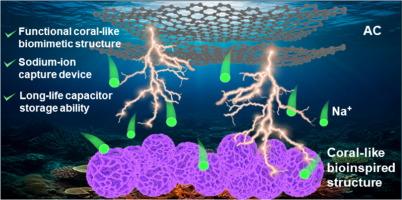仿生MnO2结构的电化学相重构提高水溶液中钠离子的储存动力学
IF 14.9
1区 化学
Q1 Energy
引用次数: 0
摘要
传统二氧化锰(MnO2)材料在钠离子超级电容器(Na-SCs)中的应用受到其低电导率和结构不稳定性的极大限制。仿生形态学工程可以优化二氧化锰的电化学性能。本文基于金属有机骨架(mof)衍生方法和电化学重构,设计了一种集成了功能氮掺杂碳(NC)涂层的珊瑚状MnO2结构,用于Na-SC应用。仿生珊瑚状结构捕获了大量的电解质离子,增加了电极表面的Na+浓度,有利于优化Na+转运途径,加快电极反应动力学。此外,珊瑚状交联结构有效地增强了mno2基电极的力学性能,使其在长期工作中能够保持结构。此外,还进行了原位/非原位表征来阐明电化学相重构过程中晶格转变的机理。此外,理论计算和仿真结果揭示了所制备电极中的离子/电子动力学。所制备的电极具有优异的电容存储能力(在0.5 A g−1时为340.7 F g−1)和循环稳定性(10,000次循环后电容保持率为85.1%)。组装的混合器件具有优异的寿命(10,000次循环后电容保持率为82.0%)和优异的能量密度(36.5 Wh kg−1)。本研究提供了一种可靠的MnO2阴极仿生形态设计策略,为高性能Na-SCs的制备铺平了道路。本文章由计算机程序翻译,如有差异,请以英文原文为准。

Electrochemical phase reconstruction of biomimetic MnO2 structure to enhance sodium-ion storage kinetics in aqueous systems
The application of conventional manganese dioxide (MnO2) materials in sodium-ion supercapacitors (Na-SCs) is considerably limited by their low conductivity and structural instability. Biomimetic morphology engineering can optimize the electrochemical performance of MnO2. Here, based on the metal-organic frameworks (MOFs)-derived method and electrochemical reconstruction, a coral-like MnO2 structure integrated with a functional nitrogen-doped carbon (NC) coating is designed for Na-SC application. The bioinspired coral-like structure captures numerous electrolyte ions and increases the Na+ concentration on the electrode surface, which is beneficial for optimizing the Na+ transport pathway and accelerating the electrode reaction kinetics. Moreover, the coral-like crosslinked structure effectively enhances the mechanical properties, enabling the maintenance of the structure of MnO2-based electrodes during long-term operation. Furthermore, in/ex-situ characterizations are performed to elucidate the mechanism of lattice transformation during electrochemical phase reconstruction. Additionally, the theoretical calculation and simulation results reveal the ion/electron dynamics in the fabricated electrode. The prepared electrode demonstrates excellent capacitance storage ability (340.7 F g−1 at 0.5 A g−1) and cycling stability (85.1 % capacitance retention after 10,000 cycles). The assembled hybrid device exhibits exceptional life-span (82.0 % capacitance retention after 10,000 cycles) and exceptional energy density (36.5 Wh kg−1). This study provides a reliable biomimetic morphology design strategy for MnO2 cathodes, paving the way for the fabrication of high-performance Na-SCs.
求助全文
通过发布文献求助,成功后即可免费获取论文全文。
去求助
来源期刊

Journal of Energy Chemistry
CHEMISTRY, APPLIED-CHEMISTRY, PHYSICAL
CiteScore
19.10
自引率
8.40%
发文量
3631
审稿时长
15 days
期刊介绍:
The Journal of Energy Chemistry, the official publication of Science Press and the Dalian Institute of Chemical Physics, Chinese Academy of Sciences, serves as a platform for reporting creative research and innovative applications in energy chemistry. It mainly reports on creative researches and innovative applications of chemical conversions of fossil energy, carbon dioxide, electrochemical energy and hydrogen energy, as well as the conversions of biomass and solar energy related with chemical issues to promote academic exchanges in the field of energy chemistry and to accelerate the exploration, research and development of energy science and technologies.
This journal focuses on original research papers covering various topics within energy chemistry worldwide, including:
Optimized utilization of fossil energy
Hydrogen energy
Conversion and storage of electrochemical energy
Capture, storage, and chemical conversion of carbon dioxide
Materials and nanotechnologies for energy conversion and storage
Chemistry in biomass conversion
Chemistry in the utilization of solar energy
 求助内容:
求助内容: 应助结果提醒方式:
应助结果提醒方式:


